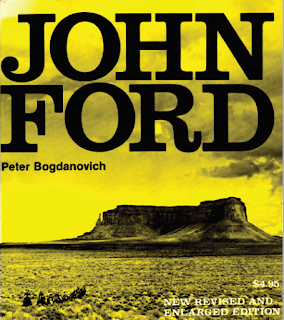"John Ford", Peter Bogdanovich
If the Nouvelle Vague became also famous for the
transition of a group of film critics to the filmmaking activity, the same cannot
be said of the New Hollywood, the American equivalent of the French
cinematographic movement. If we look for names in the United States that, in
the 60s and 70s, had similar paths to those of Godard or Truffaut, we come
across essentially with two results: Paul Schrader and Peter Bogdanovich. A former
writer for Esquire magazine, Bogdanovich
became latter known for the elegiac film The
Last Picture Show (1971), a farewell to a generation and, in a certain way,
to the classic cinema it loved, through the history of a group of adolescents
in the city of Texas during the time of the Korean War. Even though he was
part of a generation that re-invented American cinema, the cinephilia in
Bogdanovich's early films pays beautiful homages to his masters: John Ford on The Last Picture Show and Paper Moon and Howard Hawks in What's Up, Doc?
Of the
various books he wrote, the most famous are the interviews with Orson Welles made over
the course of several years and collected in This is Orson Welles, edited by Jonathan Rosenbaum; and Who The Devil Made It: Conversations with
Legendary Film Directors. About John Ford, Bogdanovich made the documentary Directed by John Ford in 1971 that
covers Ford's life and career, with interviews with some of his collaborators like
John Wayne, Henry Fonda and James Stewart. The documentary had a new version in
2006 and we could hear testimonies of filmmakers influenced by Ford such as Clint
Eastwood, Martin Scorsese, Walter Hill or Steven Spielberg.
John Ford is the monography that Bogdanovich wrote on
the American filmmaker, which, besides a brief review of his career as a whole,
includes an extensive interview with Ford where he quickly comments each one of
his films. This is the revised and enlarged edition published in 1978.
Excerpts:
"What Ford can do better than any film-maker in the world is create an epic canvas and still people it with characters of equal size and importance —no matter how lowly they may be.
It is not the concentration on Americana, however, that gives his work its unity, but the singular poetic vision with which he sees all life. His most frequently recurring theme is defeat, failure: the tragedy of it, but also the peculiar glory inherent in it."
"The end of Fort Apache anticipates the newspaper editor's line in Liberty Valance, ‘When the legend becomes a fact, print the legend.' Do you agree with that?
Yes—because I think it's good for the country. We've had a lot of people who were supposed to be great heroes, and you know damn well they weren't. But it's good for the country to have heroes to look up to."
Link to the complete book in PDF:
 |
| Peter Bogdanovich and John Ford |




Comments
Post a Comment